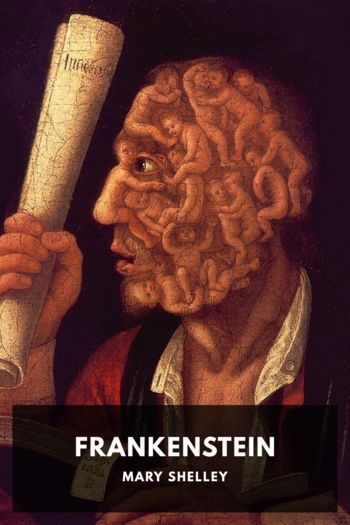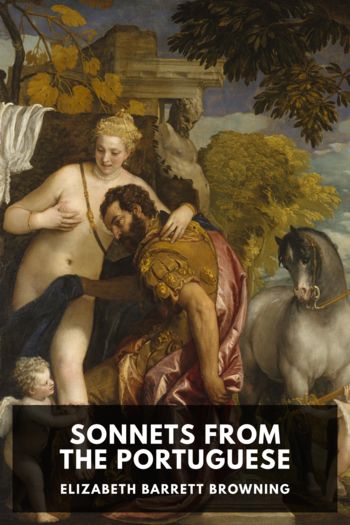Two-Way Mirror, Fiona Sampson [children's ebooks online .txt] 📗

- Author: Fiona Sampson
Book online «Two-Way Mirror, Fiona Sampson [children's ebooks online .txt] 📗». Author Fiona Sampson
Elizabeth with Flush at Wimpole Street in the mid-1840s. (Reproduced by permission of the Provost and Fellows of Eton College.)
Outside view of Casa Guidi today. (Author’s photograph.)
The interior of Casa Guidi. (Author’s photograph.)
Elizabeth and Robert in 1853; matching portraits by Thomas Buchanan Read. (Armstrong Browning Library, Baylor University, Waco, Texas.)
Outside view of the Brownings’ apartment building in Via de Bocca di Leone, Rome. (Author’s photograph.)
Studio photograph of Elizabeth in Le Havre, 17 September 1858. (Armstrong Browning Library, Baylor University, Waco, Texas.)
An engraving from the Le Havre sitting annotated by Dante Gabriel Rossetti. (Armstrong Browning Library, Baylor University, Waco, Texas.)
Detail of the same image as used by Rossetti for his portrait. (Armstrong Browning Library, Baylor University, Waco, Texas.)
A bronze cast from 1853 of Elizabeth and Robert’s clasped hands. (Armstrong Browning Library, Baylor University, Waco, Texas.)
Portrait in oils of Elizabeth aged fifty-three. (© National Portrait Gallery, London.)
Elizabeth and eleven-year-old Pen in Rome, June 1860. (Armstrong Browning Library, Baylor University, Waco, Texas.)
Drawing of Elizabeth in Rome, February 1861. (Armstrong Browning Library, Baylor University, Waco, Texas.)
Elizabeth a month before her death, photographed on 27 May 1861. (Armstrong Browning Library, Baylor University, Waco, Texas.)
Robert and Pen photographed in Venice on 14 November 1889. (© National Portrait Gallery, London.)
Frontispiece
: From within
understand
That life develops from within.
In my favourite portrait of Elizabeth Barrett Browning she simultaneously turns away and looks back over her shoulder at us. Of course in one sense every historical figure does this: glancing over their shoulder towards the future where we’re watching them, even while they face away from us into their own time. But Barrett Browning makes the gesture particularly provocative. Her wide, sensual mouth dips and rises in a curly bracket. Sceptical, even teasing, her gaze has a directness that seems startlingly modern.
Which is an irony, since it’s an image that has been constructed by thoroughly old-fashioned means. The frontispiece for the fourth British edition of her bestselling verse novel Aurora Leigh is an engraving after an ambrotype taken specifically for this purpose. On the afternoon in September 1858 when a shutter falls on the poet’s half smile, in a stuffy studio on Le Havre harbour-front, photography is understood to be neither artistic, nor detailed, enough for portraiture. It will be another half-dozen years before Julia Margaret Cameron starts to produce her famous, markedly Pre-Raphaelite images of friends and family. And so the portrait that eventually results from this sitting won’t be created by the photographer, but by a founder member of the Pre-Raphaelite Brotherhood itself.
Dante Gabriel Rossetti is a friend of ‘EBB’, as his celebrated subject likes to style herself, and of her husband and fellow poet Robert Browning. He’s a poet himself, and from its outset a decade ago the Brotherhood has placed literature, philosophy and the book arts – illustration, fine printing, binding – at the heart of its work. This commitment combined with personal acquaintance surely makes Rossetti the safest of hands for the urgent refashioning of Barrett Browning’s public image.
But his are not to be the only hands her image passes through. First it’s engraved by a less stellar craftsman, Thomas Oldham Barlow. The artist edits the result:
The hair brought a little more down more over the forehead, and the parting line not left quite so raw. More tone on the forehead and indeed all over the face. The mouth is considerably in need of correction […] by adding a line of shadow all along the top of the upper lip, thus lessening the curve upward at the corners.
Notes and sketches sprawl over Rossetti’s offprint from the engraver’s block. It would be easy to jump to the conclusion that this creator of sultry images of his own lovers – dreamy Lizzie Siddal, heavy-lidded Jane Morris – would like to ‘correct’ the poet’s appearance. But far from disparaging her, Rossetti wants his engraver to be more faithful to the ‘photograph portrait’ they’re both working from, for example by removing ‘a sort of smile not in the photograph & not characteristic of the original’.
He’s had plenty of chances to study this ‘original’ at the Brownings’ home, ‘an evening resort where I never feel unhappy’. In the two years since the hugely successful appearance of Aurora Leigh, Elizabeth’s pioneering, nine-book Bildungsroman which is the first to tell the story of a woman becoming a writer, Rossetti has admired her work and become eager to paint her. Initial impressions – ‘as unattractive a person as can well be imagined. She looks quite worn out with illness, & speaks in the tone of an invalid’ – have turned to admiring protectiveness. Now he replaces the photographer’s stock studio furniture with a symbolic writing desk, and instructs Barlow to ‘darken’ their subject’s hair and enlarge her signature dark eyes in order to make her look a little younger and less ‘worn out with illness’. After all, this portrait’s whole purpose is to ‘extinguish’ what her husband calls ‘certain horrible libels on humanity published as portraits of her in America’: portrayals all too similar to Rossetti’s own first impressions.
Earlier, shipping the photograph to Aurora Leigh’s American publishers, Robert has assured them just a shade too urgently that, ‘What you receive, is the sun’s simple truth without a hair’s breadth of retouching.’ Well. Up from Italy to spend summer 1858 with Elizabeth’s English family, the Brownings have picked out Le Havre as a halfway meeting point. On the very last day of what turn out to be two unsatisfactory, tiring months at the Normandy port, Robert finds a ‘clever man’ to conduct a photographic session with his camera-shy wife. But the result seems to justify her resistances. Jean Victor Macaire-Warnod and his brother Louis Cyrus Macaire, who share the waterside studio, are renowned technical pioneers. Yet the photographic image that will briefly see commercial distribution in North America, and be so proudly donated to the Authors’ Club of New York by littérateur Richard Henry Stoddard, is an oddly unclear and generic image. The poet’s publishers, C. S. Francis & Co, do not use





Comments (0)